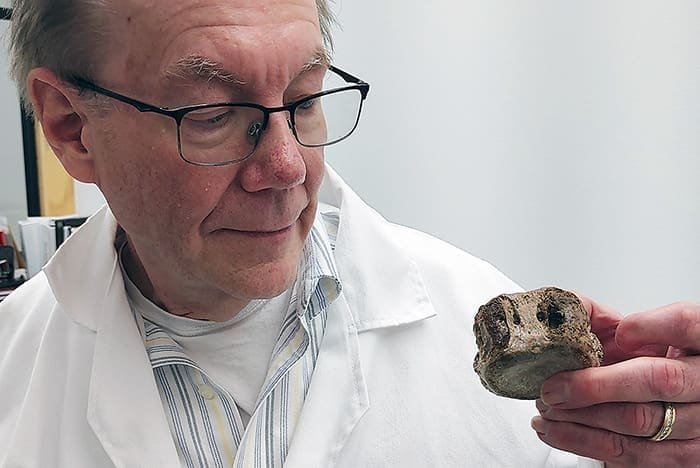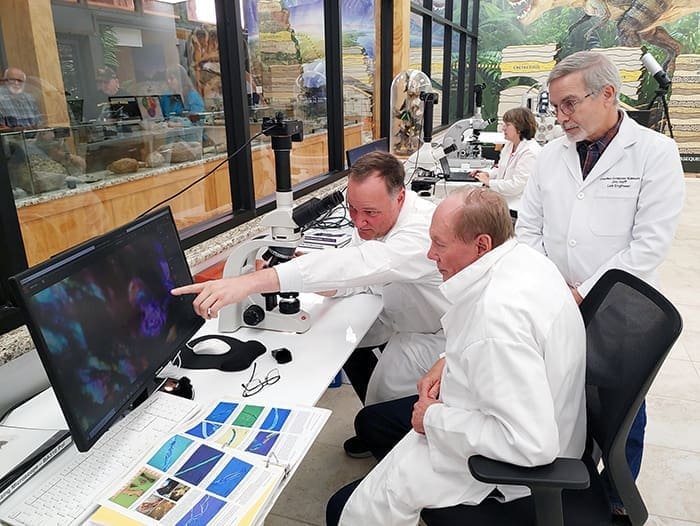 By: Dr. Jerry Bergman
By: Dr. Jerry Bergman
Montpelier, Ohio
On a recent trip to present a paper at the Creation Evidence Museum in Glen Rose, Texas, I had the opportunity to help prepare thin sections of a dinosaur era bone to look for evidence of the protein collagen.
Bones are not solids of calcium as often assumed, but living organs that grow and repair themselves throughout the lifetime of the animal.
The museum lab had access to a marine reptile plesiosaur (genus Plesiosaurus) vertebrae. It was assigned by evolutionists as Late Cretaceous, from 100.5 million years to 66 million years ago.
The vertebrae I selected to sample came from the Taylor Group in the North Sulfur River Channel of Fannin County, Texas.
Collagen is a tough protein found throughout bones, making them resilient, yet flexible. Oxygen and other chemicals react with collagen, gradually breaking it down into tiny molecules. We were concerned with the age of the bone, and thus how long ago the plesiosaur lived.
The popular view of its age is illustrated by a sign for the fossil-section of the Carnegie Museum of Natural History in Pittsburgh that claimed, “Fossils that are traces of prehistoric life have no original organic parts preserved.”

Such claims readily appear throughout popular science media, so it is no wonder that few scientists know about evidence of original organic tissues in fossils, and even fewer bother looking for the evidence.
Dr. Mary Schweitzer and her team first caught the world’s attention about tissue preservation in a 2005 Science paper that described intact blood vessels and red blood cells in a Tyrannosaurus rex bone.
If fossils are traces of life that lived many millions of years ago, then we have no reason to believe that complex organic molecules like collagen could be preserved, let alone cells or whole blood vessels.
But many fossils do contain these structures. Hardly a month passes by without new reports of “soft tissue” discovered in supposedly “million-year-old” fossils.
Could this organic material really be preserved for millions of years? I wanted to determine for myself the answer to this question.
The plesiosaur vertebrae bone I selected was cut and polished using a precision machine designed to obtain a thin slice. The wafer-thin slice was then examined using a fluorescent microscope.
Fluorescent microscopes use high intensity light to examine the specimen which excites certain minerals, causing them to fluoresce, i. e. glow.
The fluorescent minerals in turn emit a lower-energy light of a longer wavelength as do fluorescent light bulbs commonly used in offices and homes.

Fluorescence is a technique used to identify soft tissue remains within the wavelength of 315–490 nm. By this technique we were able to detect clear evidence of collagen.
The tryptophan and tyrosine within type I collagen naturally glows with strongly fluorescent properties. Collagens play an important role in the structure and function of skin, cartilage, bone, and connective tissue.
Its molecular formula is C4H6N2O3R2·(C7H9N2O2R)n. My examination, which found evidence of collagen, indicates that this bone was not even close to 66 million years old as assumed. In this research we focused on biochemicals that have measured decay rates, like collagen and DNA.
Some reports mention original hemoglobin (blood proteins) and pigments (like squid ink) in fossils claimed to be “tens-of-millions-of-years” old, but their survival times are not known with experimental certainty.
Unfortunately, evolutionists look at this evidence with their ‘evolution glasses’ and attempt to explain it away by claiming, for example, that the results are due to contamination of the bone from outside sources.
This area requires more study, but it is critical that the evidence be allowed to speak for itself without viewing it through either creation or evolutionary glasses.
———————–
Dr. Bergman is a multi-award-winning teacher and author. He has taught in the science and psychology area for over 40 years at the University of Toledo Medical College, Bowling Green State University, and other colleges. His 9 degrees include a Doctorate from Wayne State University in Detroit, Michigan. He has over 1,800 publications in both scholarly and popular science journals that have been translated into 13 languages. His publications are in over 2,400 college libraries in 65 countries. Bergman has spoken over 2,000 times at colleges and churches in America, Canada, Europe, the South Sea Islands, and Africa.

